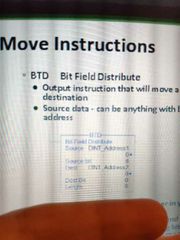![]()
![]()
![]()
Use LEFT and RIGHT arrow keys to navigate between flashcards;
Use UP and DOWN arrow keys to flip the card;
H to show hint;
A reads text to speech;
58 Cards in this Set
- Front
- Back
|
In logic 5 and 500, what are N files for? |
Numerical files. They're for doing any math instructions. |
|
|
How do we store data in the form of whole numbers in 5000? |
DINT |
|
|
Are compare instructions inputs or outputs? |
Inputs. |
|
|
What are the compare instructions? |
EQU, NEQ, LES, LEQ, GRT, GEQ, LIM. |
|
|
What are compare instructions used for? |
They're used to compare the values stored in memory locations. |
|
|
How do LES instructions work? |
If source A is less than source B, then the instruction is true. |
|
|
How do GRT instructions work? |
If source A is greater than source B, then the instruction is true. |
|
|
Are move instructions inputs or outputs? |
Outputs. |
|
|
Where can we monitor the data being moved? |
In the monitor data tags tab, right next to the edit tags tab. |
|
|
What are the different ways data can be displayed? |
Binary, octal, decimal, hex, ASCII. |
|
|
How do you change the way data is displayed? |
In the edit tags screen. |
|
|
What are the types of MOV instructions? |
MOV, MVM, BTD. |
|
|
How do MOV instructions work? |
Output instruction copies data from source to destination. |
|
|
What are MVM instructions? |
Mask move instructions. |
|
|
How do MVM instructions work? |
Copies source to destinations and allows portions of source to be ignored or "masked". 1 allows data to pass, 0 blocks bit. |
|
|
When do MVMs move data? |
Every scan that instruction is true. |
|
|
What does the MVM move? |
Only the ones data! |
|
|
What does BTD stand for? |
Bit field distribute. |
|
|
How do BTD instructions work? |
Moves a portion of source data to a different starting bit of destination. |
|

What do these numbers mean? |
0 equals starting (lowest) bit, 8 equals how many bits to send, dest equals where to send, dest bit equals starting bit number of destination, length equals how many bits you want to move. |
|
|
Are math instructions inputs or outputs? |
Outputs. |
|
|
What are the math instructions? |
ADD, SUB, MUL, DIV. |
|
|
Sub subs in which order? |
B from A. |
|
|
Div divs in which order? |
A by B |
|
|
Are math conversions inputs or outputs? |
Outputs. |
|
|
What are the math conversion instructions? |
TOD, FRD. |
|
|
What does TOD do? |
Converts integer to BCD. |
|
|
What does FRD do? |
Converts BCD value to decimal. (thumb wheel) |
|
|
What does BCD stand for? |
Binary coded decimal. |
|
|
What does MCR stand for? |
Master control reset. |
|
|
What does an MCR instruction do? |
It's used in pairs and can be used to enable or inhibit the group of rungs inside it. When the MCR rung is true, the rungs inside operate normally. When it is false, the (non-retentive) outputs inside are all deenergized. |
|
|
Can MCRs be used multiple times within the same program? |
Yes. |
|
|
Does a jump label reduce scan time? |
Yes. |
|
|
Jump must be used in conjunction with? |
Label. |
|
|
Do jump and label use tags? |
No. |
|
|
Label must be what? |
Always true. |
|
|
Can you have multiple jumps and labels with the same identifier? |
Jumps yes, labels no. |
|
|
Should you jump backwards? Why? |
No, could be in a loop for too long and trigger a watchdog timer. |
|
|
What should you never do with jumps and labels? |
Program a jump into an MCR zone. |
|
|
What does JSR mean? |
Jump subroutine. |
|
|
What are JSRs used for? |
To change subroutine file that PLC scans, to organize a program, and makes troubleshooting faster. |
|
|
Do JSRs always have to have a RET? |
No. |
|
|
JSRs. Conditional or nah? |
Either way. |
|
|
When you exit a JSR, what happens to the outputs? |
They stay in their last state. |
|
|
What type of JSRs need to have a ret? |
Nested JSRs. |
|
|
What does TND stand for? |
Temporary end. |
|
|
What does TND do? |
Ends the routine. |
|
|
What does AFI stand for? |
Always false instruction. |
|
|
What is AFI used for? |
Troubleshooting. |
|
|
What is a ONS? |
A one shot. |
|
|
What does a one shot do? |
Sends a single pulse to an output. |
|
|
What does a one shot prevent? |
Denouncing. |
|
|
What does OSR stand for? |
One shot rising. |
|
|
What does an OSR do? |
Sends the signal when input goes from false to true. On output side. |
|
|
What is the difference between an ONS and a OSR? |
When the PLC looks at the input condition. |
|
|
What does OSF stand for? |
One shot falling. |
|
|
What does an ONF do? |
Send a signal when the input instruction goes from true to false. |
|
|
What is an ONF used for? |
When you want to see that a condition has been energized. |

